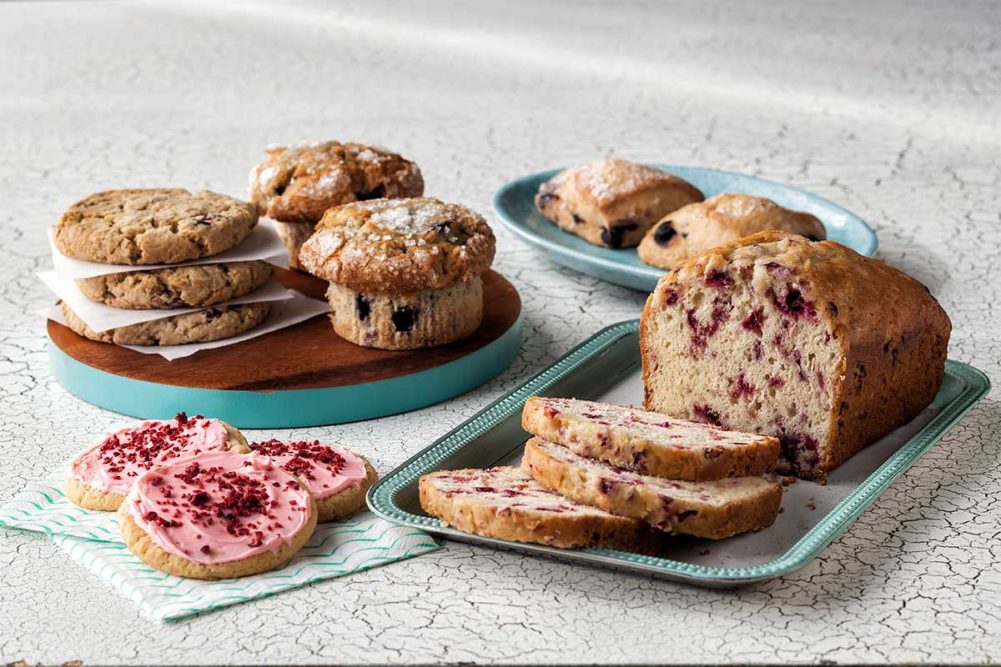Fruits and nuts — plant-based colorful, flavorful and multi-textured whole food ingredients — provide unlimited opportunities for creativity in baked goods. Choosing the right type is paramount for product success.
Bakers are attracted to including fruits and nuts as they improve the baked good’s image. The less processed and the more identifiable the fruit or nut often improves the perception of the inclusion’s nutritive value.
“Despite sometimes being overlooked in product development because of an intense focus on flavor and aroma, texture is immensely important and plays a significant role in consumer enjoyment when eating,” said Jennifer Williams, marketing director, California Walnut Board and Commission.
Inclusions can often provide a little extra bite to baked goods.
“All fruits and nuts have different physiological properties when mixed into various doughs and batters,” said Kate Leahy, spokesperson, Sunsweet Ingredients. “Some hold their shape well in a range of different applications, while others may soften or bleed. Hydration levels of the formulation itself influence how fruits and nuts will perform.”
A batter high in liquid, for example, may cause even the crunchiest of nuts to soften. And excessive moisture from juicy fruits may hinder a batter from rising properly.
“The amount of kneading and mixing involved can also change the outcome,” Ms. Leahy said. “When mixed in toward the end of the process, inclusions will have a better chance of holding onto their texture integrity. Long-resting cycles for doughs may also soften inclusions or cause them to bleed because there’s more time for the dough moisture to permeate the inclusions.”
Indeed, moisture content is an important attribute. It must be considered in both directions, the moisture in the fruit or nut as well as the batter or dough.
“For baked goods like scones and muffins, formulators need to consider the water activity of the fruit being used,” said Heidi Farkas, national sales and marketing manager, MicroDried. “Fruit formats with higher water activity can lead to shorter shelf life.”
There are several questions a formulator should address when seeking out fruit ingredients, according to Jeannie Swedberg, director of customer development and marketing, Tree Top Inc.
“First, you want to think about the format of the fruit ingredient,” she said. “What’s your application? What’s your objective? Are you looking for identifiable fruit pieces or just fruit content? Does flavor, sweetness or dietary fiber content matter? Then you’ll want to consider the type of fruit in which you’re interested.
“If you add a vibrantly colored fruit puree, such as blackberry, to a batter or dough, you will change the color of the batter, and consequently, the finished baked good,” Ms. Swedberg continued. “We view this as a positive. Having a distinctive, attractive color can add to the appeal of a baked good.”
When it comes to nut selection, adding a layer of protection to nutmeats may slow rancidity as well as provide a moisture barrier. That layer of protection also enhances the overall eating experience.
“Nuts oxidize over time, and this is accelerated when exposed to heat, light and oxygen,” said Claudia Granda, vice president of research and development, Pecan Deluxe. “Also, some nuts oxidize faster than others. The formulator should take into consideration the finished product shelf life desired when choosing what nuts to use.”
While fruits and nuts provide nutrition, they also add calories. Fruits will likely increase total sugar content while nuts influence total fat content.
“Adjustments to moisture, fat, sugar and emulsifier levels may need to be made,” said Bogdan Farjon, bakery principal scientist, Kerry Ingredients.
This article is an excerpt from the April 2021 issue of Baking & Snack. To read the entire feature on fruits and nuts, click here.





